Please use the following link to download the December 7, 2024 issue of the syəcəb
Culture-fueled cheer power
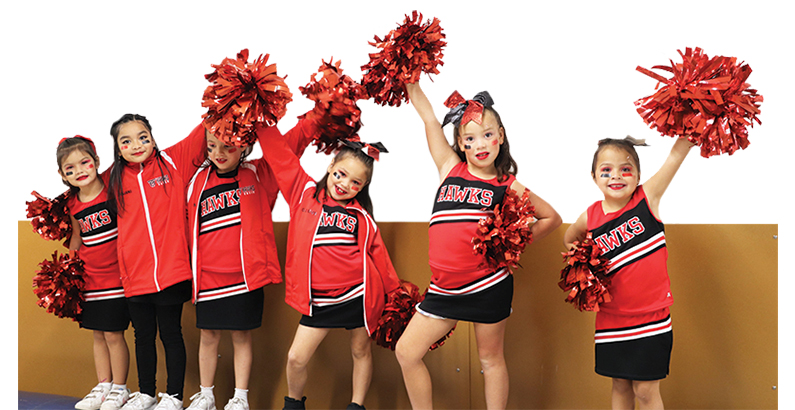
By Micheal Rios, Tulalip News
Cheerleading is recognized for an energetic blend of athleticism, teamwork, and performance. Beyond the glittering pom-poms and dazzling routines, youth cheerleading serves as a platform for empowering young girls, largely driven by women leaders who act as mentors, coaches, and role models.
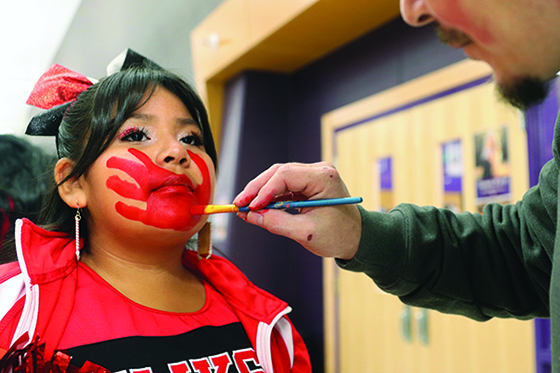

At its core, cheer promotes physical fitness and discipline. These benefits to a youth’s physical wellbeing are good, but even better are the emotional, spiritual, and psychological impacts. The high energy, choreographed activity instills critical life skills such as teamwork, communication, and resilience. Girls learn to work collaboratively toward common goals, celebrate collective achievements, and navigate setbacks with grace and determination.
Central to this empowering experience are the women who lead cheerleading programs, like Tulalip’s own Sheena Oldham and assistant coach Tara Granquist who together lead Lady Hawks cheer. As coaches and mentors, they hold a unique position to influence and inspire the next generation of young women. Through their guidance, they strive to model leadership, strength, and perseverance.
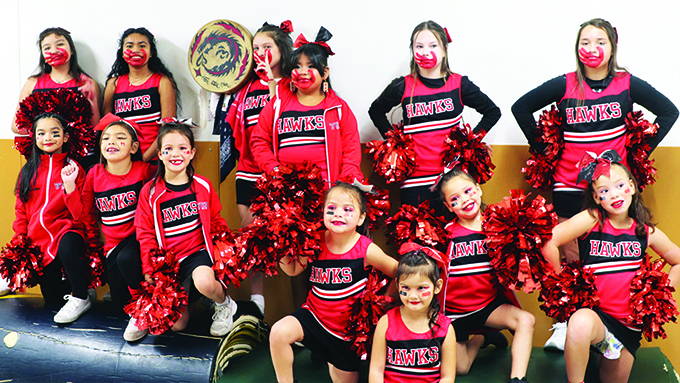
“We basically started this program from scratch after a few girls came to me during my day job with Youth Services and said ‘We want to cheer, but there are no on Rez options’,” explained cheer coach Sheena. “I reached out in-person and online to every family I knew that might be interest in signing up their daughter or daughters. At our first practice, we had maybe 8 or 9 girls total. A couple months later, we had 42. Enough to form two teams of different age groups (5 to 8-years-old and 9 to 12-years-old).
“From day one, I’ve wanted our program to be about more than just nailing a routine. It’s about our girls learning to support each other and finding confidence in who they are. Getting them to come out of their shells and breaking them of their shyness by building up their confidence levels and helping them find their voice. We even had a few troublemakers that clearly didn’t have an issue using their voice who we challenged in the best kind of way by getting them into leadership roles. Now, their voices help advocate for their teammates and for woman all across Indian Country.”

For young girls, cheer squad can be a safe space where they can explore their feminine identity and develop a strong sense of belonging as part of a shared sisterhood. Cheer’s emphasis on community involvement also allows girls to see firsthand the impact of their efforts. From cheering on school teams to participating in community projects, cheerleaders often become ambassadors of positivity and encouragement, learning the importance of giving back.
The young flock of Lady Hawks amplified their voices and took their united effort for giving back to the next level during their NCYFL Cheer Showcase performance. Held during mid-November at Anacortes High School, the Lady Hawks coaches and cheerleaders proved they could pay tribute to Native American Heritage Month during their performance while openly advocating for Missing and Murdered Indigenous Women.
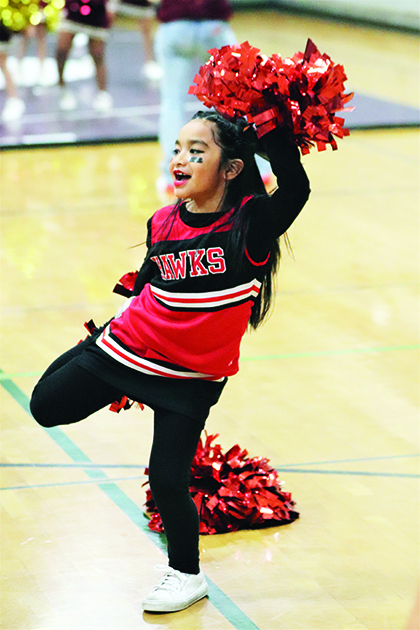
The jam-packed Anacortes gymnasium went completely silent as hundreds of cheer spectators took in the Lady Hawks routine. Equal parts cultural pride, social advocacy, and in sync pom-pom maneuvers, the girls wowed onlookers when their hip-hop music abruptly cut out and was replaced with a live drumming and singing of Antone George’s MMIW anthem.
Concluding their awe-inspiring performance, cheerleaders Persaeus Fryberg and Laveigha Merritt read the following statement: “MMIW means Missing and Murdered Indigenous Women. The song you just heard was created by Antone George of the West Shore Canoe Family in 2019. The U.S. Department of Justice found that Native American women face murder rates that are much higher than the national average. Four out of five of Native women are affected by violence. Our purpose of singing and dancing this song is to bring awareness to our sisters who are no longer here to speak for themselves.”
When the two elder Lady Hawks dropped the mic, they and their squad of red hand wearing cheerleaders were met with a thunderous applause. Both coaches and several cheer moms greeted the girls with gigantic, warm embraces as they exited the gymnasium and received their cheer medals.

Head coach Sheena valiantly held back tears while lofting praise on her team. “I’m so extremely proud of each and every one of our girls. Seeing them out there in front of so many people and not missing a beat, it’s just an amazing experience. They’ve worked so hard to reach this point and to see all that hard work pay off with a performance and reception like that is, well what else can it be, it’s epic!”
At a time when positive female role models are more important than ever, youth cheerleading stands out as an illustrious lane for nurturing leadership and, in the case of Tulalip’s Lady Hawks, cultural empowerment. The women at the helm of these programs and the girls they are entrusted with are creating ripples of change. One squad, one routine, and one cheer at a time.
Dads Group provides support on the fatherhood journey

By Kalvin Valdillez, Tulalip News
Back in May, the Washington Fatherhood Council and Tulalip Family Haven held an event known as the Fatherhood Café at the TELA gymnasium. With the intention to connect local fathers with resources and information, the four-hour gathering garnered nearly 30 participants.
During this session, each father displayed a strong desire to learn as much as they could about becoming a better parent and were highly interactive throughout the afternoon. This work allowed the dads to open up about the challenges they face as Indigenous fathers. And it also provided them the opportunity to relate to one another and create bonds with other parents who are on a path toward the same goals.
Working together, the dads identified areas where they needed that extra support and guidance in their fatherhood journey from either the community, family members, or the Tribe. Topics included addiction recovery, reunification efforts, reintegration after incarceration, housing, employment, cultural and community gatherings, and assistance through the justice system.
The Fatherhood Café resulted in a monthly gathering, planned by the dads for the dads, aptly dubbed Dads Group. Receiving a little guidance from Family Haven, the dads organize fun and engaging meetings that are kid and family friendly. With close to a dozen regular attendees, the dads are fully invested and are embracing that fatherhood role and all the challenges and successes that come with it.
Dads Group is a unique experience that isn’t available on many reservations. At each meet up, they allow themselves the space and time be vulnerable and delve into heavy topics such as the loss of a child, the struggle of addiction, or the possibility of never seeing their kids again.
And in response, the other dads show support by not only lending an ear and a shoulder, but also by offering advice and sharing how they got through similar problems in the face of adversity. Whether that’s cultural activities, spiritual work, group therapy, or even the incorporation of exercise into their daily lives, the dads keep an open mind and showcase a willingness to try new ideas and experiences.
Now, though the topic of conversation may be serious, the vibe and air of the room is kept light. As Indigenous People, we will find a way to get our laughs in and bring that Native humor to the forefront of that heavy work. After all, laughter is a big part of healing for our people, and there is plenty of that to go around at Dads Group.
The local dads often pick a theme and activity for the gatherings including traditional arts and crafts, as well as some holiday fun for the kiddos. The last two Dads Group meetings were based around the season, in October the group carved pumpkins while they chatted. And the activity for November was turkey hand crafting, just in time for Thanksgiving.
As the Dads Group moderator, Sasha Smith, Family Haven’s Family and Youth Support Coordinator, helps keep the conversation rolling while also introducing new topics and providing resources/contact info based on the conversation.
Said Sasha, “Family Haven has always had the Moms Group and supports for the moms, but there were never supports for dads. We know that dads are just as important to the family, whether it’s working, providing for your children, introducing culture, making sure they’re getting those teachings in the home. We realized that there wasn’t anything for dads, there’s really a lack of that out here, and that’s the missing link. And I realized that if there wasn’t going to be somebody else doing it, that I just needed to step up. So, I took the Moms Group model and used that to start the Dads Group.”
She continued, “I think that modern society always tells us that men shouldn’t speak up, men have to hold in their thoughts and feelings. But we know that is not good for our mental health. It’s not healthy to be alone, whether you’re in recovery, active addiction, maybe you’re going through separation, a divorce, whatever you are going through in life, it’s not healthy to do it alone. And whether it’s negative or positive, all those emotions are really raw, but once you learn that this is a safe space, then you realize it’s okay to let others be there to support you. At the end of the day, we’re all human and as Native people, we need that connection where we sit down, share a meal, and talk about whatever we’re going through.”
At the latest Dads Group, Robert Coberly and Dustin Moses shared an open discussion about their personal journey. They planned an outing for the group to visit a local CrossFit gym in Marysville. They also spoke about how a number of different Tribal programs and departments helped them along the way, including the Healing Lodge, Village of Hope, the MAP program, and the Healing to Wellness Court.
When asked about why Dads Group is important to have in the community, Robert shared, “For the support. I come here for support for myself and to support other dads and connect them with resources. We did a BBQ and pumpkin carving last month and I got to bring my daughter. It’s great to be a part of this support group and hang out with the other dads and learn how they’re doing in life and just be a part of it.”
Dustin added, “Dads Group is beneficial for dads to access more knowledge on being a better parent and how to help yourself in the long run. This group has helped me in so many ways and I’ve had a whole bunch of new experiences so far. My first time coming here was really interesting because I learned a lot about the culture and parenting information. And it’s helping me learn more about myself. I’m really enjoying it.”
To bring the two-hour gathering to a close, Sasha assigned the dads some homework that they can do with their kids – watch the Disney Pixar movie, Inside Out, because they will be focusing on dealing with emotions at the next group meeting.
Sasha shared that the Dads Group meet ups and outings will vary month to month and that the dads try to plan the group on days that will accommodate the majority of the participants schedules. She also extended an invite to the uncles and grandpas in the community who are helping raise children in their families.
“Continue watching for the flexibility of the schedule,” she said. “We’re trying to make it as easy as possible. You don’t have to commit to the full two hours, you can drop in, grab a snack, grab a coffee. And once you do that a few times, just like everything in life, you start to build in that routine. And that’s we we’re doing here – teaching routine and consistency. I know that at first it can be a bit uncomfortable, but in order for us to learn, especially with our kids, we have to be uncomfortable to experience new things. So, swing by, say hi, and just feel out the vibe and the energy of the space.”
For more information, please contact Robert Coberly at (360) 640-8858, or Family Haven at (360) 716-3284.
Jason Lee O’Day

Jason Lee O’Day, 34, passed away November 25, 2024 in Everett.He was born on March 1, 1990 to Patrick and Carmen O’Day in Everett, Washington. He was a member of the Tulalip Tribes. He loved his children Susan and Jason D.L. O’Day. He lived his life the best that he could. He is survived by his parents, Patrick and Carmen; brother Brian; and children Susan and Jason. A celebration of his life will be held Wednesday, December 4, 2024 at 10 AM at the Tulalip Gathering Hall with burial to follow at Mission Beach Cemetery.
November 23, 2024 syəcəb
Please use the following link to download the November 23, 2024 issue of the syəcəb
Holiday cheer at Native Bazaar

By Wade Sheldon, Tulalip News
On November 15-16, the Tulalip Gathering Hall hosted the first of two annual Holiday Native Bazaars organized by tribal member Tammy Taylor. This year, the event featured over 60 tribal vendors showcasing handmade crafts and goods. Attendees explored an impressive selection of items, from traditional Native regalia such as cedar hats, baskets, and jewelry to handmade quilts, soaps, candles, and paintings. The bazaar offered smoked salmon, deer, elk, banana bread, cookies, and various popcorn flavors for food lovers.

Vendor Lorina Jones expressed her excitement about the event’s success. “This is our second year here. Our freeze-dried candy and earrings sold quite well.” When asked for her overall impression of the bazaar, Jones replied, “I think it went well—there were many vendors and lots of people left with great gifts. Everyone is together, laughing, having a good time. It’s just a fantastic opportunity for us to sell the crafts we love creating.”

Taylor highlighted the unique nature of the gifts available at the bazaar. “There are so many beautiful gifts here—things you can’t find anywhere else, made with love, care, and prayers. That’s the best part. People look forward to this event every year. Some vendors have told me how much they appreciate having this opportunity to sell their crafts and make money for things they need.”

Taylor emphasized the community spirit fostered by the bazaar. “This is about more than just selling; it’s about gathering and sharing. You see young people, some as young as 14 or 15, bringing their baked goods to sell. It’s heartwarming to watch. And then you have vendors like Mike Gobin, whose beautiful carved rattles were flying off the table, or The Golden Girls—tribal members Heather, Toni Jo, and Judy Gobin—laughing and weaving together. Watching them enjoy themselves is what this event is all about.”
She also praised the artistry on display, mentioning Lance Taylor’s cedar hats, Mike Dunn’s wooden coat racks, and many other unique items. “There’s just so much beautiful art here,” she said. “I encourage everyone to come out and support tribal member vendors. Everything is made with care and talent, whether someone has just a handful of items or several tables.”
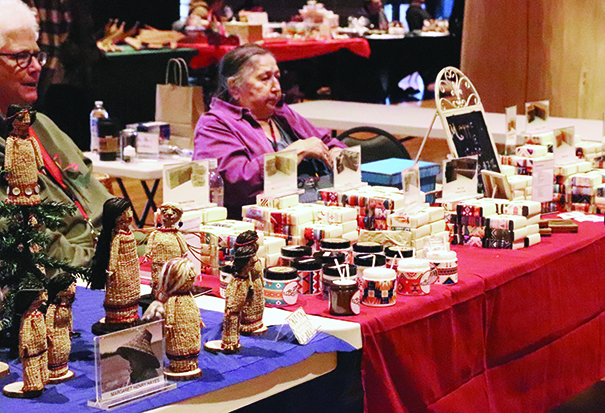
Taylor thanked the Tulalip Tribes for providing the gathering hall and the Quil Ceda Village graphics team for creating the event’s banners each year. “They always do an amazing job,” she said. “This event wouldn’t be possible without their support and the dedication of everyone involved.”
Another Holiday Bazaar will be held on December 6 and 7 at the Gathering Hall. Tulalip tribal member vendors only, for questions reach out to Tammy Taylor at (425) 501-4141
Bringing culture to the playground
TELA introduces five new culturally inspired playgrounds

By Kalvin Valdillez, Tulalip News
“To see this all come to life is so beautiful. These are not your typical playgrounds – you can’t find this everywhere. This is related to us and to our kids.” – Taylor Burdett, TELA ECEAP Preschool Manager

The Betty J. Taylor Early Learning Academy (TELA) recently unveiled not one, not two, not three or four, but five new playgrounds at their campus earlier this fall. Featuring state-of-the-art equipment, the new play areas afford their students the opportunity to expand their knowledge of the local animals and aquatic life, as well as the habitats in which they live.
Furthermore, the playgrounds are accented with Tulalip specific pieces, such as cedar dugout canoes, a life-size replica of the Tulalip longhouse, salmon and orca slides, and a dock that overlooks Tulalip Bay. And there are still a few more installations on the way that will enhance the cultural experience for the kids during outdoor playtime. This includes a smokehouse and a clam pit, where the students can learn how to traditionally prepare the foods of the Tulalip people such as clams, mussels, and smoked salmon.
“I think it’s really about being able to share with the children who they are and where they come from,” said Sheryl Fryberg, TELA Director. “HeadStart talks about how community is so important in early childhood education because it gives them that sense of self-pride and builds their self-esteem. So, the more they know about their own community, the better they’re going to thrive in k-12 and through their college career and life, knowing this is who I am and this is where I come from.”

The project was over five years in the making, according to TELA Manager, Mekyla Fryberg, who spearheaded the effort. The academy began its initial planning phase prior to the pandemic, and when covid hit, the project was put on the back burner. But Mekyla was determined to see it all the way through, and she was able to secure additional Covid-19 funding to utilize for the playgrounds. She also took on the responsibility of finding a contactor and purchasing the equipment, with a goal to complete the project by the end of September 2024.
Said Mekyla, “We have installed five new playgrounds – one specifically for birth-to-three, the rest are for ages 2-5. We have our fishermen’s dock playground; our longhouse, which will be surrounded by our smokehouse and our clam pit, where we focus on Indigenous foods with our students; our sea-life playground; and our wilderness preschool play area. And in addition to those areas, we did some renovations and added in play structures into our inner courtyard playground that was already pre-standing.”
After giving an exclusive tour of all five play areas to the syəcəb, Mekyla shared a little bit about the theme of the playgrounds, which revolve around local wildlife. She stated, “We tried to be intentional with the animals that we chose for the playgrounds and capture the classroom names that we have within our facility. We have our sea-life animals and our small land animals on the birth-to-three wing of the building. And our bigger land animals and birds in the preschool wing.”
To get a better understanding of Mekyla’s statement, let’s take a closer look at a few highlights of each playground. At the renovated inner courtyard, children will find a forest-themed playground with birch tree steppingstones and plenty of interactive fun such as a native wildlife soundboard. And sculptures of butterflies, bears, and bluejays can be found high and low throughout this entire play area.
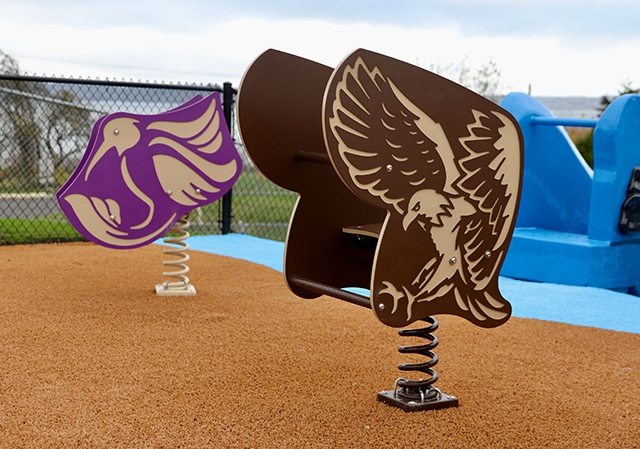
Next up, there is the fishermen’s dock, which not only features the canoe and the salmon/orca slides, but also a realistic pier play structure. Complete with perched seagulls and observation viewers, the kids can look out at the bay and feel as though they are at the Tulalip Marina. A few more cool pieces at this playground include oyster steppingstones and also hummingbird and eagle spring riders.
Across the fishermen’s dock is the field where TELA holds its annual clambake ceremony. A permanent spot has been reserved for the clam pit, which sits directly in front of the new longhouse. The longhouse was modeled after Tulalip’s own cedar longhouse and the attention to detail is nothing short of stunning.

“They [contractors] actually went down to our longhouse and were able to replicate the posts,” Mekyla explained.
Sheryl added, “We are going to develop it so that it looks more like it did when we lived in our longhouses. We want to get like food storage, and baskets, and something that replicates tule mats. I’m just so excited about it because it really gives the kids that feel. When we bring them to our longhouse, even the young kids, they feel when they walk in the door, that it’s different in there.”
Next on the tour is the sea-life playground that is located on the birth-to-three side of the academy. Upon entrance, the kids are greeted with a deep blue playground turf that serves as a replica of the Salish Sea. A whale’s tail appears to be jutting out of the ocean on the far side of the turf. On its opposite side is the head of an orca swimming alongside her calf, giving the illusion that the killer whale’s body is underwater. A few more highlights of the sea-life playground are sealion sculptures, jellyfish slides, and a giant figure of a sea turtle.
The fifth and final playground can be found on the preschool side and is known as the wilderness playground. All the equipment on this playground is painted brown and green, to provide that outdoorsy vibe for the kids. Sitting on top of the main play structure is an owl looking out from a tree canopy. And below, the kids can reach the slides by climbing cedar logs and three cedarwood cookie steppingstones. In addition to the owl, the wildlife of this play area consists of a howling wolf, two bears, and a mama deer cuddled next to her fawn.

The wilderness playground also has a few key features that we’d be remiss to mention. For the first time, in all of TELA’s history, the academy has a full-fledged swing set. And directly across the new swing set is perhaps the main attraction of the wilderness playground, a section with imported sand, rocks, and driftwood from the local coastline. TELA brought the beach to the academy! And it’s proving to be a place that many of the students connect with the most.
“One of our teachers said that this is like the serenity spot for the kids,” shared Sheryl. “They run and play hard everywhere else but when they get here, they just relax. It’s like hitting Mother Earth, right? It brings such joy to my heart because we have provided so many different opportunities for them to be outside. And learning outside is the best thing we can do for our children; to experience the world, so they’re not just stuck in the classroom. They get to learn about their animals and even the sounds of the animals.”
Following the exclusive tour, the three TELA leaders took a moment to share their personal favorite playgrounds with Tulalip News.
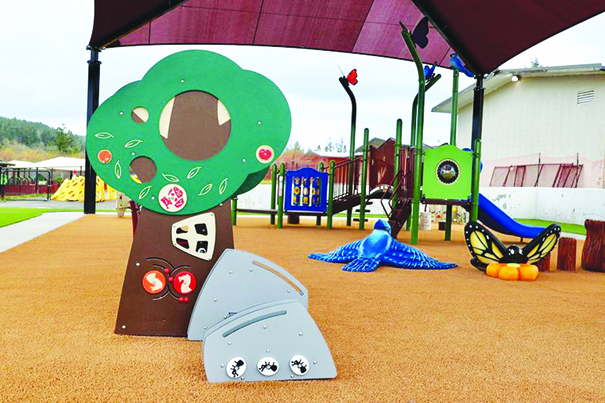
“I think the fisherman dock is my favorite,” Mekyla exclaimed. “We have the salmon and killer whale slides. And just being able to scan out on the dock while you’re looking at the bay. I also like to see that it gives some of our teachers the opportunity to engage and learn as well, and so that’s also really rewarding for me.”
Taylor expressed, “I don’t have a favorite place but the little details of everything is my favorite, like the little oyster shells and the little accessories everywhere. From covid, we’ve seen an increase in our developmental delays and our sensory needs of our students. So, we just tried to expand that outside of the classrooms and to give them opportunities on the playground. There’s secured safe sounds, there’s a lot of different noise, auditory, and feely-sensey things for them and that’s so great.”
“The longhouse is my favorite because it gives us the opportunity to show the way we lived originally in our longhouses as well as how we utilize them today,” Sheryl revealed. “And it’s going to be a great place for our teachers and our Lushootseed department to share traditional stories and knowledge with our kids.”
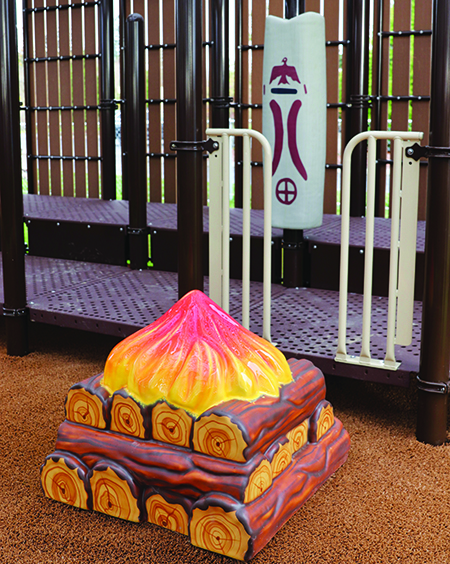
Since its establishment, the early learning academy has continued to find new ways to incorporate the Tulalip culture and their ancestral knowledge into their curriculum. The new playgrounds are an extension of those ideals and values of the academy. And just a few weeks after introducing the play areas to their students, the kids are already in love with the animal sculptures and culturally inspired play structures, and they are having a blast exploring every detail of the new parks.
If you have yet to see the new playgrounds, the fishermen’s dock and longhouse are visible from the academy’s parking lot. Please keep in mind that in order to preserve the pristine look of the new play structures for future generations, the new playgrounds are closed to the public. For additional info, please contact TELA at (360) 716-4250.
Giving thanks the Tulalip Cares way

By Micheal Rios, Tulalip News
Since the inception of the Tulalip’s Charitable Contributions Fund in 1993, the Tribe has donated approximately 126 million dollars in support to thousands of unique organizations. More commonly known as Tulalip Cares, the Fund provides the opportunity for a sustainable and healthy community by providing much needed funding to Washington State nonprofits and community groups who strive to make our shared reality a better place for all.
Kicking off the start of the holiday season, the Tribe, Resort Casino, Quil Ceda Village and Tulalip Cares combined forces to host an extravagant evening dubbed Raising Hands. It’s an annual event representing the purest spirit of Thanksgiving.
Held in the Orca Ballroom, the always stylish space was filled with hundreds of representatives who work tirelessly to improve education, environmental stewardship, public services, cultural preservation, and health care within the state. Guests were cordially invited to come together in an atmosphere of appreciation to celebrate their common mission to improve our communities.

“First of all, I want to welcome everyone here to our homelands,” said Tulalip Board of Director Glen Gobin during his opening remarks. “Secondly, I’d like to thank each and every one of you for the work that you do in helping us build stronger communities, bringing people together for the common good, and recognizing opportunity gaps and doing what it takes to fill those gaps. You all truly represent what it means to step forward and make a difference.
“We’ve experiences so much growth since 1992 when Tulalip signed the first gaming compact in Washington State. As we’ve grown, we haven’t forgotten what it is like to be in need,” continued Glen. “The Tulalip Tribes started out with only 3 employees many years ago. Today, we have over 3,600 employees and work with over 7,900 vendors, most of whom are local and could be your neighbor. As we continue to grow and be successful, we maintain our responsibility to the greater community and uphold our traditional value of giving back. That is why we are so very proud to have provided over $6.2 million dollars in financial assistance to 500+ organization over the past year.”
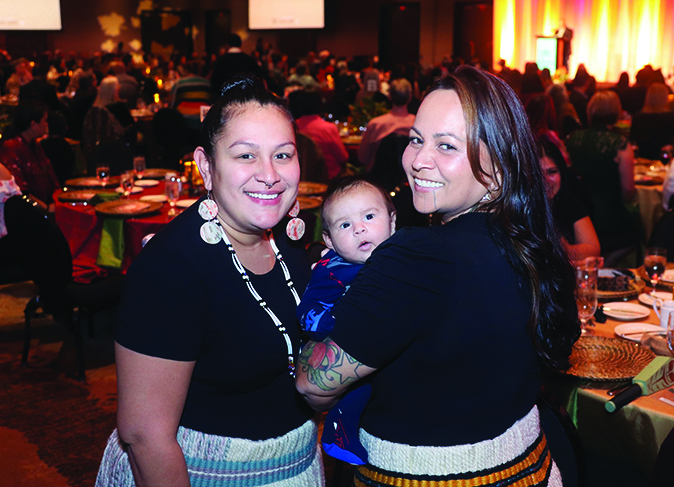
Raising Hands isn’t just about dollars and cents. At the annual celebration, community change makers are given a chance to share their plans for the future and learn how other like-minded charities are striving to make a difference for the benefit of so many. This is an invaluable benefit for organizations who can sometimes struggle to get their message broadcast to larger audiences.
“When you see people having these amazing, positive conversations that is when we see we are making a difference,” observed Tulalip Cares Director Marilyn Sheldon. “Giving people the opportunity to work together is worth its weight in gold. We try to show respect and honor these charities that give so much of themselves for this community. We want them to feel like the red carpet got laid out just for them.
“Each year, as soon as the event is over, we ask ourselves how we can help make the next one better,” she continued. “Some days, I feel so blessed that this is my job. We are so fortunate to be able to work with these amazing organizations in Snohomish County and throughout Washington State.”

During the 2024 rendition of Raising Hands, six standout nonprofits received special recognition for their exceptional creativity and effectiveness. Little Bit Therapeutic Riding Center, Naa KáaniNative Program, Pacific Rim Institute for Environmental Stewardship, Purrfect Pals, Scarlet Road, and STEM Paths Innovation Network were each highlighted for their innovative and heart felt work.
While cinematic videos detailing the amazing work of the featured nonprofits played on the Orca Ballroom’s several projection screens, the hundreds of honored guests in attendance were treated to a delectable 5-course dining experience.

The event ended with one last giving of thanks. One that paid tribute to still thriving Tulalip lifeways that are at the core of Tulalip Care’s vision to create a healthy and vibrant community. “To be without trees would, in the most literal way, to be without our roots,” read a table sign that attendees were directed to visit while exiting the Ballroom. On the table were gifts aplenty in the form of Western Red Cedars. Those that accepted the gift of cedar were instructed to plant it as a living memory of the special night of giving.
November 16, 2024 syəcəb
Please use the following link to download the November 16, 2024 issue of the syəcəb
Highlighting heritage on the banks of Lake Washington
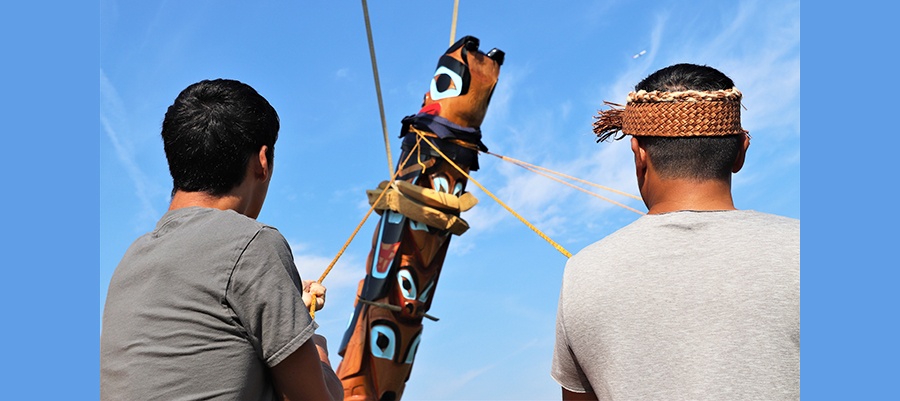
By Micheal Rios, Tulalip News
Last issue, in celebration of Native American Heritage Month, we highlighted the educational exploits of one soon-to-be Tessa Campbell, Ph.D. who is actively indigenizing space on the University of Washington campus. This issue we turn our celebratory gaze to the awe-inspiring artistry of James Madison and a towering story pole installed on the banks of Lake Washington.
One of Tulalip’s master carvers, James is celebrated not only for his dedication to preserving our rich cultural heritage but also for his exceptional skill and craftsmanship in wood carving. His expansive portfolio, especially his soaring story poles, exemplifies his mastery in the art of Coast Salish carving and his commitment to upholding the stories and iconic imagery of his ancestors

“I started learning how to carve at 5-years-old. Some of my earliest carving memories are from when I’d be dropped off at my grandma Lois and grandpa Frank’s house every day during elementary,” recalled the now 50-year-old James in an episode of Hibulb Conversations. “I’d basically receive my culture teachings from them in the morning, before going to school at Whittier Elementary, then continue the culture teachings with them after school. Back then, my grandpa would carve around the kitchen table. He’d sit me down with my cousin Steven and we would watch and learn.”
James comes from an artistic family that spans multiple generations and includes both Tulalip and Tlingit forebearers who were deeply rooted in cultural traditions and storytelling. They used a variety of tools and elements that were at their disposal at the time to display their most valued aspects of culture through art.


Within the modern competitive art scene of the 21st century, true masters of their craft seek to expand beyond the confines of what art should be and, instead, revel in the opportunity to express what art is. An ever-evolving perspective that isn’t limited by palette nor medium, Native American artists are always seeking innovative methods to highlight heritage like those who came before them.
“I always dreamt of being an artist like my grandpa and father before me,” admitted the Tulalip master carver. “There was a Haida artist named Bill Reid, who I never actually met in person, but he had a profound impact on me through his books filled with northwest coastal art and stunning sculptures that were 15- to 20-feet large. When I was young, his books were accessible to me and I’d look through them constantly; studying his technique and visualizing what I’d do if I had the ability to create things larger than life.”
Out of that larger than life vision has sprung a stunning, one-of-one story pole. The core of a 600-year-old Red Cedar tree has been intricately hand-carved into a traditional story that has been passed on from one generation to the next. Depicted in the 20-foot tall, 2,000-pound pole is a traditional tale passed on from a grandfather to his grandson during one of those aforementioned culture teachings as child.

“My grandpa used to tell me this story about Thunderbird and Black Fish, which depicted the origins of Snoqualmie Pass,” explained James moments after the pole’s raising. “A long time ago, there used to be thunderbirds flying in the sky. When they flapped their wings, they made lighting and thunder. Black Fish swam in the ocean, but would come to the surface from time and time and jump out when necessary to gather. Whenever Thunderbird and Black Fish saw one another, they’d become jealous of what the other could do. One could fly and one could swim.
“They would bicker to each other and brag about which ability was better, swimming or flying. One day, they just had enough of each other’s talk and decided to fight. Thunderbird swooped down from the sky as Black Fish leapt from the water and they met in mid-air. They tussled around, fighting each other, until they eventually landed on the mountains. They continued their tussle, crushing their way through mountainous rock down until they reached the water. Thunderbird soared back into the sky and Black Fish propelled itself back into the ocean. What their fight created was a path over the mountain that we know today as Snoqualmie Pass.”
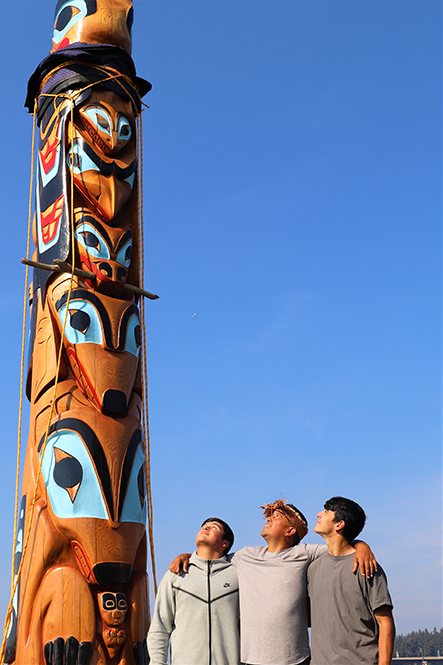
It took James one full year of meticulous carving with various tools and techniques, from chisels and adzes to sanders and finishing tools, to complete this story pole. His control over each tool further demonstrates his mastery, allowing him to achieve the deep textures, contours, and details that give his cedar formed figures life and meaning.
Behind the story, literally on the pole’s back, are six animals that were requested to represent the commissioner’s family. Seahawk, bear, sea otter, wolf, shark, and beaver totems only add to the cultural significance the pole represents in the heart of Coast Salish territory. Through artistic vision, James and his fellow master carvers are creating a future in which our culture thrives and inspires. They are connecting the past, present and future through an enduring art form – storytelling in wood.